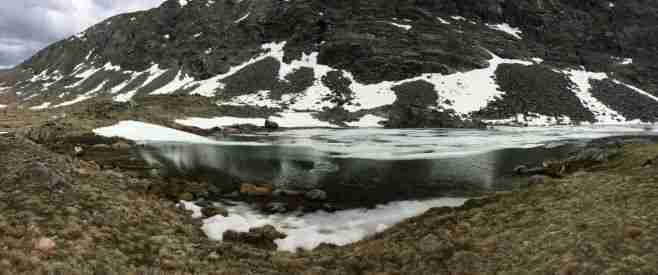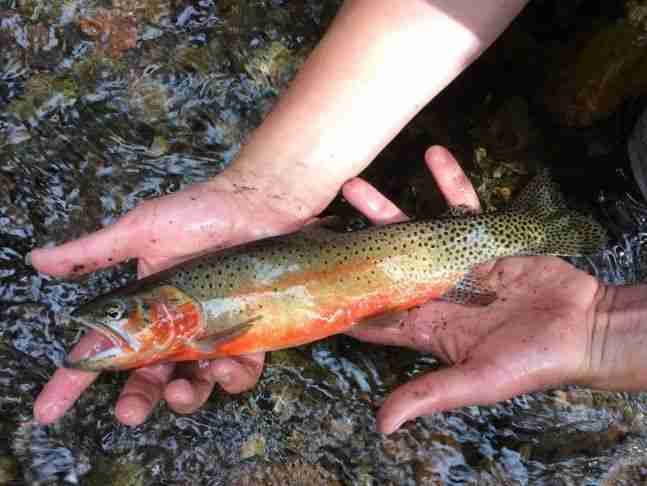So, you’ve been fishing rivers and lakes around your home town, but you want to try something new. You want to catch a species of fish you’ve never caught before. You want to get away from it all and make some memories in the mountains. Here we breakdown our top five tips for planning an alpine fly fishing trip. Fishing mountain lakes and streams gives you the amazing combination of awesome fishing and unbelievably beautiful scenery. I go on numerous trips every year all over the West. Here are some things I’ve learned in the past 10 years to help you get started on your next alpine fly fishing trip.
Josh alpine fly fishing for arctic grayling
Find an area that has lots of opportunities
Alpine lakes are different than lakes and rivers at lower elevations. They are covered in ice for long portions of the year and depending on weather, they are self-sustaining or need to be stocked, the fishing can be good one year and terrible the next. That’s why it’s good to pick an area that has lots of alpine lakes at various elevations. I’ve been on many trips where the lake I was hoping to fish was covered with ice so I had to adjust my plans and move to a different lake. In Wyoming, I’ve found that usually most alpine lakes are free of ice by July 4th. However, some of my best trips have been on lakes that were half covered in ice so don’t hesitate to try a couple casts even if you think the fishing might not be good. Also, don’t forget to look for other things to do on your trip in the rare instance that fishing may not work out. Often I will pick a mountain I want to summit in the area. I also will often bring climbing shoes to do some bouldering.
Alpine lake
Pack light for alpine fly fishing trips
When I go on an alpine fly fishing trip that involves a lot of hiking I am always thinking of weight. I do not generally bring waders. I bring a small fly box. I bring one rod, usually a 5 wt. I always store my fly rod in a tube to protect it from branches and mice. A web search of ultralight backing will help you find lots of good tips for lightening your load. One trick I learned early on is using an alcohol stove. They save weight and are almost impossible to break.
Backcountry camping and fly fishing
Be prepared for bad weather and wildlife
The high alpine can be dangerous. Thunderstorms can emerge out of nowhere on an alpine fishing outing. I’ve been stuck in snow storms in July. My personal preference is to bring one layer more than I think I will need. Usually for a four day trip in the summer I bring two t-shirts, stocking cap, thin gloves, a thin sweatshirt, a puffy down jacket, one pair of pants, some thin swimming trunks, two pairs of socks and a rain jacket. Bugs can be bad so I bring a mosquito head net as well. Bringing extra warm layers also allows you to bring a lighter sleeping bag as your down jacket can give you extra insulation at night. The wildlife can be unpredictable as well. Depending on where you are going grizzly bears can add another level of complexity to a trip. Mice and marmots will also try to eat the cork off your fly rod because of the salt which is why I always keep my rod in its tube at night.
Mountain storm
Bring a variety of flies
Trout in alpine lakes are usually biting. I usually fish with dry flies in the evening and mornings. I like streamers and nymphs during the day when the wind is blowing. I always start at the inlet or outlet of the lake. Sometimes shallow rock beds are also good places to start. Matching the hatch is rarely an issue. For dry flies I generally just bring some attracter patterns like Humpy’s, Adams Irresistibles (my personal favorite), black ants and a half dozen Parachute Adams in different sizes. As for streamers I use a lot of cone headed streamers as they are able to get deeper where I tend to have better luck. I usually only bring bead headed nymphs again because they allow me to fish deeper.
Wild San Juan Cutthroat trout
Be respectful and leave no trace
This one should be obvious yet it only takes a few inconsiderate people to really make a negative impact. Pack out toilet paper and do not wash your dishes in the lake. While alpine fly fishing, be sure to camp at least 100 feet from the lake. Don’t leave tippet material all over the shore. Catch and release is strongly encouraged, especially with wild native fish. Try not to camp right next to other backpacking groups. In areas that allow fires keep them small. If we all do our part we can preserve these amazing areas for future generations to enjoy.
Mountain fly fishing trip






